
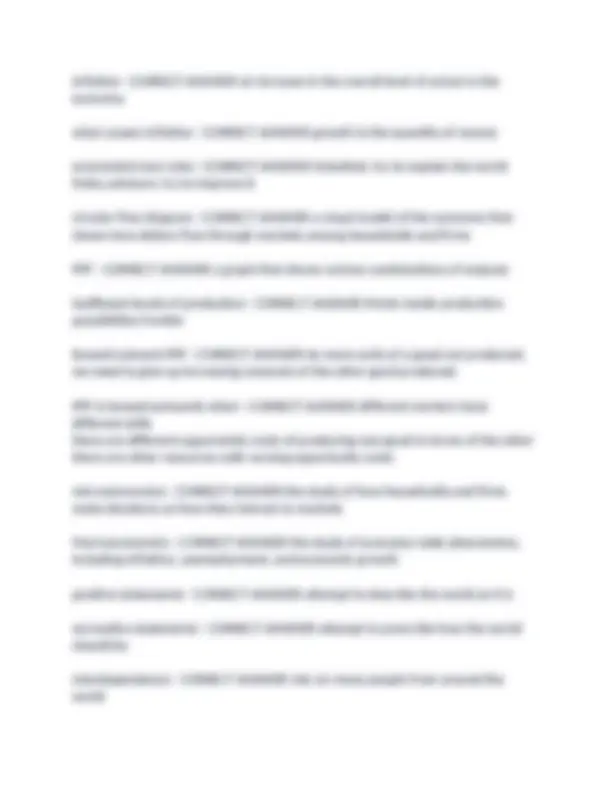
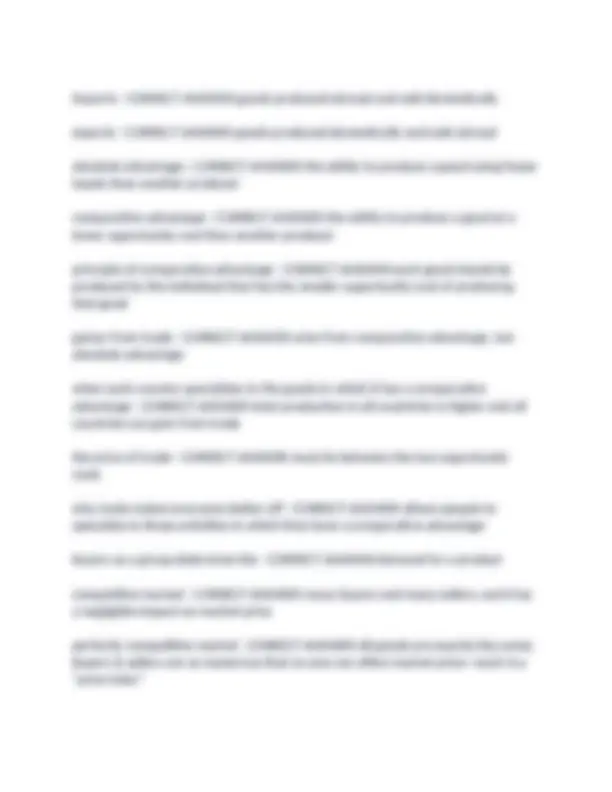
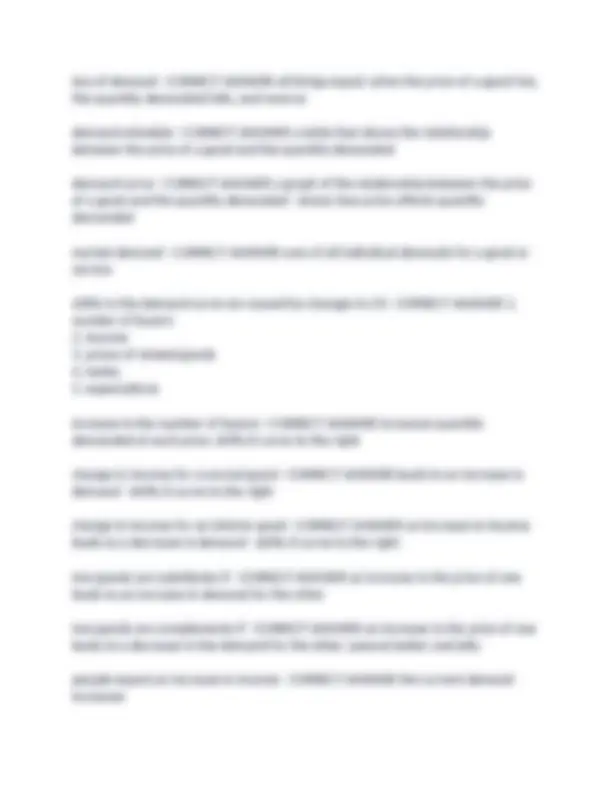
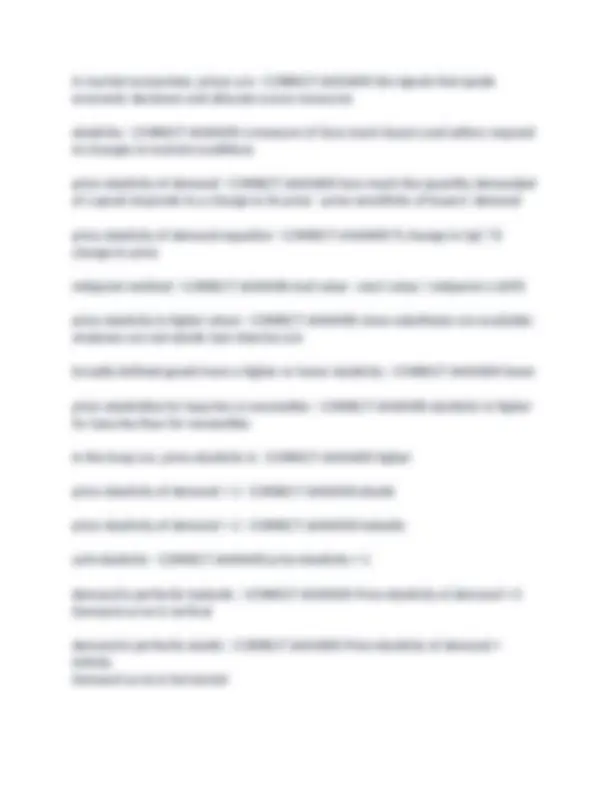
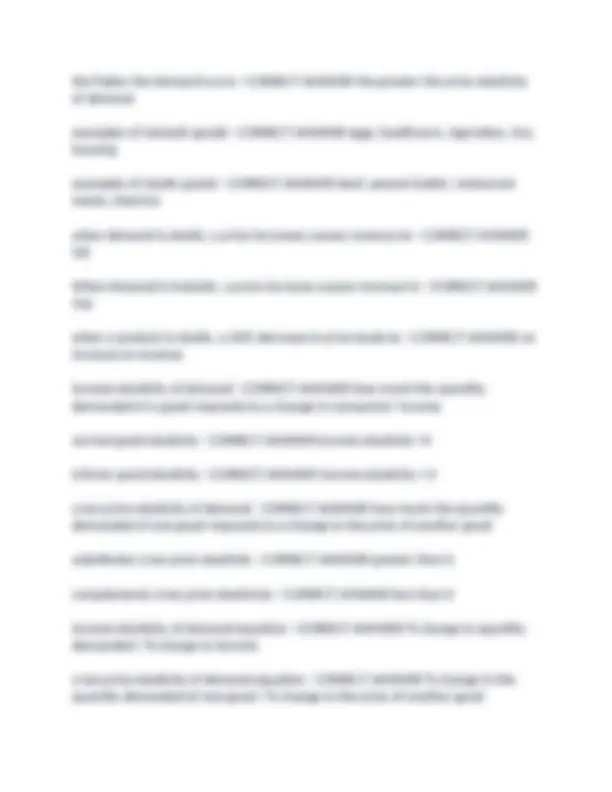
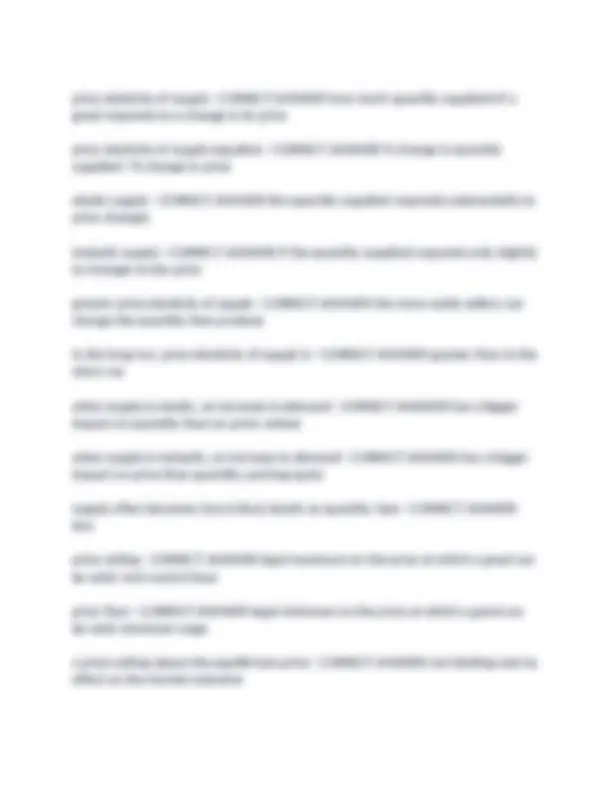


Study with the several resources on Docsity

Earn points by helping other students or get them with a premium plan


Prepare for your exams
Study with the several resources on Docsity

Earn points to download
Earn points by helping other students or get them with a premium plan
Community
Ask the community for help and clear up your study doubts
Discover the best universities in your country according to Docsity users
Free resources
Download our free guides on studying techniques, anxiety management strategies, and thesis advice from Docsity tutors
A comprehensive set of 138 questions and verified answers covering key concepts in introductory economics. It covers topics such as scarcity, opportunity cost, market forces, supply and demand, and the role of government in the economy. Suitable for students taking an introductory economics course, providing a valuable resource for exam preparation and understanding fundamental economic principles.
Typology: Exams
1 / 12

This page cannot be seen from the preview
Don't miss anything!







Economics - CORRECT ANSWER the study of how society manages its scarce resources scarcity - CORRECT ANSWER the limited nature of society's resources principle 1 - CORRECT ANSWER People face trade-offs principle 2 - CORRECT ANSWER The cost of something is what you give up to get it principle 3 - CORRECT ANSWER Rational people think at the margin principle 4 - CORRECT ANSWER People respond to incentives efficiency - CORRECT ANSWER society gets the maximum benefits from its scarce resources equality - CORRECT ANSWER economic prosperity is distributed uniformly among society's members opportunity cost - CORRECT ANSWER whatever must be given up to obtain some item marginal changes - CORRECT ANSWER small incremental adjustments to a plan of action example of thinking at the margin - CORRECT ANSWER hiring a cashier that would cause $400 additional revenue and makes $300 per week government - CORRECT ANSWER enforce property rights and promote efficiency and equality
incentive - CORRECT ANSWER something that induces a person to act source of market failure - CORRECT ANSWER externality (how the production affects bystanders) and market power ( a single buyer or seller has too much power) principle 5 - CORRECT ANSWER Trade can make everyone better off principle 6 - CORRECT ANSWER Markets are usually a good way to organize economic activity principle 7 - CORRECT ANSWER Governments can sometimes improve market outcomes market - CORRECT ANSWER a group of buyers and sellers market economy - CORRECT ANSWER allocates resources through the decentralized decisions of many households and firms as they interact in markets prices - CORRECT ANSWER determined by the interaction of buyers and sellers - reflect the good's value to buyers Principle 8 - CORRECT ANSWER A country's standard of living depends on its ability to produce goods and services principle 9 - CORRECT ANSWER Prices rise when the government prints too much money principle 10 - CORRECT ANSWER Society faces a short-run trade-off between inflation and unemployment productivity - CORRECT ANSWER the quantity of goods and services produced from each unit of labor input most important determinant of living standards - CORRECT ANSWER productivity
imports - CORRECT ANSWER goods produced abroad and sold domestically exports - CORRECT ANSWER goods produced domestically and sold abroad absolute advantage - CORRECT ANSWER the ability to produce a good using fewer inputs than another producer comparative advantage - CORRECT ANSWER the ability to produce a good at a lower opportunity cost than another producer principle of comparative advantage - CORRECT ANSWER each good should be produced by the individual that has the smaller opportunity cost of producing that good gainsv from trade - CORRECT ANSWER arise from comparative advantage, not absolute advantage when each country specializes in the goods in which it has a comparative advantage - CORRECT ANSWER total production in all couintries is higher and all countries can gain from trade the price of trade - CORRECT ANSWER must lie between the two opportunity costs why trade makes everyone better off - CORRECT ANSWER allows people to specialize in those activities in which they have a comparative advantage buyers as a group determine the - CORRECT ANSWER demand for a product competitive market - CORRECT ANSWER many buyers and many sellers, each has a negligible impact on market price perfectly competitive market - CORRECT ANSWER All goods are exactly the same; Buyers & sellers are so numerous that no one can affect market price—each is a "price taker"
law of demand - CORRECT ANSWER all things equal, when the price of a good rise, the quantity demanded falls, and reverse demand schedule - CORRECT ANSWER a table that shows the relationship between the price of a good and the quantity demanded demand curve - CORRECT ANSWER a graph of the relationship between the price of a good and the quantity demanded - shows how price affects quantity demanded market demand - CORRECT ANSWER sum of all individual demands for a good or service shifts in the demand curve are caused by changes in (5) - CORRECT ANSWER 1. number of buyers
a cost-saving tech improvement - CORRECT ANSWER has the same effect as a fall in input prices a decrease in the number of sellers - CORRECT ANSWER decreases quantity supplied at each price - shifts supply curve to the left change in supply - CORRECT ANSWER A shift of the supply curve caused by a change in a variable other than the price of the product change in the quantity supplied - CORRECT ANSWER a movement along a fixed supply curve occurs when price changes equilibrium - CORRECT ANSWER price has reached the level where quantity supplied equals quantity demanded surplus - CORRECT ANSWER quantity supplied is greater than quantity demanded
in market economies, prices are - CORRECT ANSWER the signals that guide economic decisions and allocate scarce resources elasticity - CORRECT ANSWER a measure of how much buyers and sellers respond to changes in market conditions price elasticity of demand - CORRECT ANSWER how much the quantity demanded of a good responds to a change in its price - price-sensitivity of buyers' demand price elasticity of demand equation - CORRECT ANSWER % change in Qd / % change in price midpoint method - CORRECT ANSWER end value - start value / midpoint x 100% price elasticity is higher when - CORRECT ANSWER close substitutes are available; airplanes are not elastic but cheerios are broadly defined goods have a higher or lower elasticity - CORRECT ANSWER lower price elasticities for luxuries vs necessities - CORRECT ANSWER elasticity is higher for luxuries than for necessities in the long run, price elasticity is - CORRECT ANSWER higher price elasticity of demand > 1 - CORRECT ANSWER elastic price elasticity of demand < 1 - CORRECT ANSWER inelastic unit elasticity - CORRECT ANSWER price elasticity = 1 demand is perfectly inelastic - CORRECT ANSWER Price elasticity of demand = 0 Demand curve is vertical demand is perfectly elastic - CORRECT ANSWER Price elasticity of demand = infinity Demand curve is horizontal
price elasticity of supply - CORRECT ANSWER how much quantity supplied of a good responds to a change in its price price elasticity of supply equation - CORRECT ANSWER % change in quantity supplied / % change in price elastic supply - CORRECT ANSWER the quantity supplied responds substantially to price changes inelastic supply - CORRECT ANSWER if the quantity supplied responds only slightly to changes in the price greater price elasticity of supply - CORRECT ANSWER the more easily sellers can change the quantity they produce in the long run, price elasticity of supply is - CORRECT ANSWER greater than in the short run when supply is elastic, an increase in demand - CORRECT ANSWER has a bigger impact on quantity than on price; wheat when supply is inelastic, an increase in demand - CORRECT ANSWER has a bigger impact on price than quantity; parking spots supply often becomes (more/less) elastic as quantity rises - CORRECT ANSWER less price ceiling - CORRECT ANSWER legal maximum on the price at which a good can be sold; rent-control laws price floor - CORRECT ANSWER legal minimum on the price at which a good can be sold; minimum wage a price ceiling above the equilibrium price - CORRECT ANSWER not binding and no effect on the market outcome
price ceiling below the equilibrium price - CORRECT ANSWER is binding and causes a shortage effects of a binding price ceiling - CORRECT ANSWER shortage arises and sellers must ration scarce goods among potential buyers price floor below equilibrium price - CORRECT ANSWER not binding - has no effect on the market outcome price floor above equilibrium price - CORRECT ANSWER binding and causes a surplus effects of a binding price floor - CORRECT ANSWER causes a surplus and undesirable rationing mechanisms- sellers who appeal to buyers' personal biases may be better able to sell their goods ___ are usually a good way to organize economic activity - CORRECT ANSWER markets tax incidence - CORRECT ANSWER the manner in which a burden of a tax is shared among participants in a market A tax on buyers will shift the - CORRECT ANSWER demand curve downward by the amount of the tax a tax on sellers will shift the - CORRECT ANSWER supply curve upward by the amount of the tax elastic supply, inelastic demand with tax - CORRECT ANSWER buyer pays more of the tax - easier for sellers to leave the market than buyers inelastic supply, elastic demand with tax - CORRECT ANSWER seller bears more of the tax - easier for buyers to leave the market than sellers luxury items - CORRECT ANSWER demand is elastic, supply is inelastic, tax burden falls largely on the suppliers